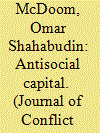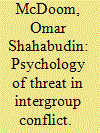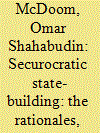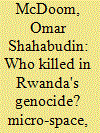|
|
|
Sort Order |
|
|
|
Items / Page
|
|
|
|
|
|
|
| Srl | Item |
| 1 |
ID:
133716


|
|
|
|
|
| Publication |
2014.
|
| Summary/Abstract |
Although popularly perceived as a positive force important for objectives such as economic development and democracy, social capital may also be linked to less desirable outcomes. This article highlights a dark side to social capital by pointing to its role in a particularly pernicious phenomenon: genocidal violence. Drawing on a survey of residents from one community that experienced violence during Rwanda's 1994 genocide, I show that individual participation in the violence was partly determined by the features of residents' social networks. Perpetrators possessed larger networks in general and more connections to other perpetrators in particular. The quality as well as quantity of connections also mattered. Strong ties generally, and kinship and neighborly ties specifically, were strong predictors of participation. In contrast, possession of countervailing ties to nonparticipants did not reduce a resident's likelihood of participation. Drawing on in-depth interviews to explore the possible mechanisms behind these findings, I suggest participants' networks fulfilled functions of information diffusion, social influence, and behavioral regulation. More broadly, the findings suggest the importance of social structure and social interaction for participation in collective violence. Relational data should complement individual attribute data in predicting participation. The findings also suggest, contrary to the neo-Malthusian interpretation, that the role played by Rwanda's extraordinarily high population density in the violence may have been more sociological than ecological in origin. The diffusion, influence, and regulatory effects of social connections are likely to be amplified in communities where individuals live in close spatial proximity to each other.
|
|
|
|
|
|
|
|
|
|
|
|
|
|
|
|
| 2 |
ID:
115346


|
|
|
|
|
| Publication |
2012.
|
| Summary/Abstract |
How do security threats mobilize social groups against each other? The strength of such threats lies in the power of group emotions, notably the primary emotion of fear. Fear works by activating psychological processes at the group level that polarize attitudes between different groups. An analysis of survey data, radio broadcasts, and interviews from Rwanda's civil war and genocide of 1990-94 reveals four psychosocial mechanisms at work in group polarization: boundary activation, outgroup derogation, outgroup homogenization, and ingroup cohesion. Additionally, scholarly debates on the role of emotions, material opportunities, and rationality in ethnic conflicts represent a false theoretical choice. Both emotions and material opportunities matter, and rationality and emotion are not incompatible. Two simple refinements to extant theoretical and empirical approaches are needed. First, scholars ought to distinguish between attitudes and violence in ethnic conflicts; emotions matter for the polarization of attitudes, but material and structural opportunities mediate their expression as violence. Second, scholars should pay greater attention to the extensive research in social psychology that shows that both emotion and reason interact in individual judgment and decisionmaking.
|
|
|
|
|
|
|
|
|
|
|
|
|
|
|
|
| 3 |
ID:
191628


|
|
|
|
|
| Summary/Abstract |
Both popular perspectives and theoretical characterizations of Rwanda’s remarkable trajectory following the genocide remain polarized more than a generation after the violence. The country has been hailed as a developmental state and denounced as an authoritarian ‘ethnocracy’. I introduce the concept of securocratic state-building in response to this polarization. The construct is intended to capture, first, the regime’s developmental but non-doctrinaire ambitions, synthesizing liberal and illiberal precepts; and second its prioritization of security over liberty, favouring stability over peace. I then draw on a set of interviews with key Rwandan opinion-makers drawn from across the country’s principal political and social divides to elicit the competing rationales given for each of three grand strategic choices made by the regime: why it eschewed competitive politics; why it sought to re-engineer society and efface ethnicity; and why it moved to modernize the state and the economy. The juxtaposition of these opposing opinions exposes a fundamental tension at the heart of the securocratic state-building model: the regime’s aspiration for unity is at odds with its preoccupation with security. This strategic contradiction, I argue, places a question mark over the long-term sustainability of the Rwanda model.
|
|
|
|
|
|
|
|
|
|
|
|
|
|
|
|
| 4 |
ID:
122898


|
|
|
|
|
| Publication |
2013.
|
| Summary/Abstract |
In episodes of intergroup violence, which group members participate and which do not? Although such violence is frequently framed as occurring between distinct ethnic, racial or sectarian groups, it is easily overlooked that it is usually only a subset of the group's members who in fact participate in the violence. In predicting participation, extant research has privileged an atomistic approach and identified individual attributes indicative of a predisposition to violence. I suggest instead that a situational approach should complement the atomistic paradigm and present evidence that an individual's micro-spatial environment is an important predictor of differential participation in intergroup violence. Using GIS data on 3,426 residents from one community, I map the household locations of participants, non-participants, and victims of Rwanda's 1994 genocide. I find that participants are likely to live either in the same neighbourhood or in the same household as other participants. Specifically, as the number of violent to nonviolent individuals in an individual's neighbourhood or household increases, the likelihood of this individual's participation also increases. In explaining these neighbourhood and household effects, I suggest social influence is the mechanism at work. As micro-spatial distance decreases, micro-social interaction increases. Neighbours and household members exert influence for and against participation. Participation then may be as much the product of social interaction as of individual agency. What neighbours and family members think, say and do may influence participation in collective action such as intergroup violence. The conceptualization of neighbourhoods and households as micro-spheres of influences suggests the importance of social structure as a determinant of participation.
|
|
|
|
|
|
|
|
|
|
|
|
|
|
|
|
|
|
|
|
|